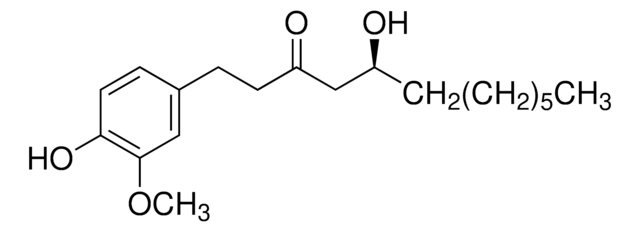推荐产品
化驗
≥98% (HPLC)
應用
metabolomics
vitamins, nutraceuticals, and natural products
儲存溫度
2-8°C
SMILES 字串
CCCCCCCCC[C@H](O)CC(=O)CCc1ccc(O)c(OC)c1
InChI
1S/C21H34O4/c1-3-4-5-6-7-8-9-10-18(22)16-19(23)13-11-17-12-14-20(24)21(15-17)25-2/h12,14-15,18,22,24H,3-11,13,16H2,1-2H3/t18-/m0/s1
InChI 密鑰
AIULWNKTYPZYAN-SFHVURJKSA-N
正在寻找类似产品? 访问 产品对比指南
一般說明
[10]-Gingerol is a pungent, non-volatile phenolic compound of fresh ginger root.
應用
[10]-Gingerol has been used as an antibacterial agent to study its effects on Escherichia coli ATP synthase. It has also been used as an anti-hyperglycemic agent to test its effects on promoting glucose utilization in 3T3-L1 adipocytes and C2C12 myotubes.
生化/生理作用
[10]-Gingerol is a potent anti-cancer agent and a known inhibitor of breast cancer cells growth by blocking cell proliferation and inducing programmed cell death. It also inhibits ovarian cancer cells growth by inducing G2 phase cell cycle arrest. 10-Gingerol elicits inhibitory effects towards triple breast cancer cells in both mouse models and in vitro studies. It also displays anti-neuroinflammatory and anti-hyperglycemic activities.
[10]-Gingerol is a bioactive compound found in ginger (Zingiber officinale) with anti-inflammatory and antioxidant activity.
訊號詞
Warning
危險聲明
危險分類
Eye Irrit. 2 - Skin Irrit. 2 - STOT SE 3
標靶器官
Respiratory system
儲存類別代碼
11 - Combustible Solids
水污染物質分類(WGK)
WGK 3
閃點(°F)
331.3 °F - closed cup
閃點(°C)
166.3 °C - closed cup
其他客户在看
Megan M Bernard et al.
Experimental and molecular pathology, 102(2), 370-376 (2017-03-21)
The ginger rhizome is rich in bioactive compounds, including [6]-gingerol, [8]-gingerol, and [10]-gingerol; however, to date, most research on the anti-cancer activities of gingerols have focused on [6]-gingerol. In this study, we compared [10]-gingerol with [8]-gingerol and [6]-gingerol in terms
Andrea Rasmussen et al.
Advanced pharmaceutical bulletin, 9(4), 685-689 (2019-12-21)
Purpose: Gingerol homologs found in the rhizomes of ginger plants have the potential to benefit human health, including the prevention and treatment of cancer. This study evaluated the effect of 10-gingerol on ovarian cancer cell (HEY, OVCAR3, and SKOV-3) growth.
Su-Chen Ho et al.
Food chemistry, 141(3), 3183-3191 (2013-07-23)
Despite the anti-neuroinflammatory capacity of ginger, the corresponding active constituents are unclear. This study analyzed the composition of fresh ginger ethanolic extract by using LC-MS. Inhibitory activities of fresh ginger extract and seven gingerol-related compounds on the neuro-inflammation were also
Meran Keshawa Ediriweera et al.
Molecules (Basel, Switzerland), 25(14) (2020-07-16)
10-gingerol is a major phenolic lipid found in the rhizomes of ginger (Zingiber officinale). Being amphiphilic in nature, phenolic lipids have the ability to incorporate into cell membranes and modulate membrane properties. The purpose of the present study was to
Chien-Kei Wei et al.
International journal of molecular sciences, 18(1) (2017-01-21)
The anti-diabetic activity of ginger powder (Zingiber officinale) has been recently promoted, with the recommendation to be included as one of the dietary supplements for diabetic patients. However, previous studies presented different results, which may be caused by degradation and
我们的科学家团队拥有各种研究领域经验,包括生命科学、材料科学、化学合成、色谱、分析及许多其他领域.
联系技术服务部门
![[10]-姜酮醇 analytical standard](/deepweb/assets/sigmaaldrich/product/structures/224/210/b4f3e699-03b9-4112-89c1-a63f196344d0/640/b4f3e699-03b9-4112-89c1-a63f196344d0.png)


![[6]-姜烯酚 analytical standard](/deepweb/assets/sigmaaldrich/product/structures/378/737/6e6bd2f9-0152-45e1-8006-344ca92937be/640/6e6bd2f9-0152-45e1-8006-344ca92937be.png)





